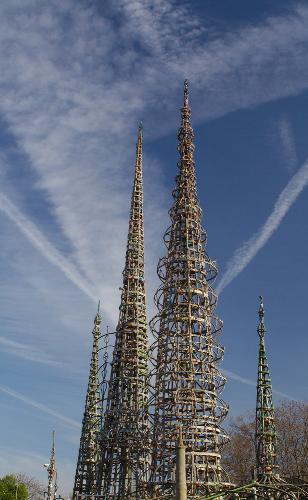
Made of structural steel covered with mortar and adorned with a mosaic of broken glass, seashells and ceramics, seventeen major sculptures make up the body of public artwork known as the Watts Towers. They are the creation of a single individual, Sam Rodia (1879~1965), who immigrated to the United States from Italy just before the turn of the century.
Rodia found work on the West Coast as a construction worker in rock quarries, logging camps and railroad enclaves. In 1921, he purchased a triangular-shaped lot at 1761-1765 107th Street in Los Angeles, where he began constructing the project he called Nuestro Pueblo, or "our town.'' In his own words, "I had it in mind to do something big and I did it.''
Over the next 34 years, Rodia toiled by day and sculpted by night. He used no machines or power equipment, no bolts, welds or rivets. He had no scaffolding, no board designs, and no assistance. Singlehandedly, Rodia used pipe-fitter pliers and a window-washer's belt to build his towers, the tallest of which reaches 99.5 feet into the air and has been recognized as "the longest slender reinforced concrete column in the world.''
Next to the tallest tower are two similar spires, one reaching 97 feet and the other 60 feet. Other sculptures here include a gazebo with a circular bench, three bird baths, a center column, and a tower reaching a height of 38 feet. The portion of the monument known as "Rodia's Ship of Marco Polo'' has a 28-foot spire, and the "South Wall'' stretches out for 140 feet, decorated with tiles, pottery, seashells, glass and hand-drawn designs.
Today, the Watts Towers serve as a monument to Rodia's vision, which has been compared to the artistry of Spaniard Antoni Gaudn (1852~1926). It has survived fires, demolition orders from the Department of Building and Safety, riots, vandalism and urban renewal efforts to remain a symbol of individual creativity and the undaunted human spirit.
In 1975, the sculptures, land, and adjacent Arts Center building were deeded over to the City of Los Angeles for operation and maintenance. Restoration of the three main towers took place in 1978. Since 1985, the property has been preserved under the operation of the city's Cultural Affairs Department.
The Watts Towers are now listed on the National Register of Historic Places and as a National Historic Landmark. They constitute a State of California Historic Park and have been designated as Historic-Cultural Monument Number 15 by the City of Los Angeles Cultural Heritage Commission.
General admission to the Watts Towers Art Center, which displays changing art exhibitions, is $7 per adult and $3 for seniors and youth aged 13~17. Children 12 and under are admitted free of charge. Tours are conducted around the open fence, with volunteers providing historical detail and little known facts to visitors for a suggested donation of $5. The tours are conducted every half hour or so on Fridays from 11am to 3pm, Saturdays from 10:30am to 3pm, and Sundays from 12:30pm to 3pm. The limit is twenty people per tour. Participation is on a first come first served basis. No tours are held on rainy days.
The Watts Towers of Sam Rodia are located near the intersection of Wilmington Avenue and Santa Ana Boulevard North at 1761-1765 East 107th Street, Los Angeles California 90002. The closest freeway exit is 117th Street on the I-105 West.
Review, comment, or add new information about this topic: